Freaky ramps
Today I was back at Corson's Brook Woods in Staten Island for my Torrey plant walk. I came across this: 
Gratuitous wildflower photo of downy yellow violet (Viola pubescens).
This is a plant ecologist's tour of the five boroughs - the vagaries of urban ecology in New York City, including native flora, invasive plants, insects, and the things 8 million people do to 53,000 acres of natural area.
Today I was back at Corson's Brook Woods in Staten Island for my Torrey plant walk. I came across this: 
Gratuitous wildflower photo of downy yellow violet (Viola pubescens).
Posted by
drosera
at
10:08 PM
0
comments
![]()
Labels: spring ephemerals, springtime, Staten Island, wildflowers
All this rain is ruining my plant walks! I've been looking forward to the Raritain River floodplain walk on Torrey Botanical Society's field trip page. Bluebells, bluebells, and bluebells. They are really just gorgeous. And, for some reason, not in New York. So, I would've gotten my fix if it hadn't rained. And I hadn't gotten lost. Instead, I went to Sourland Mountain Nature Preserve.




Posted by
drosera
at
9:15 PM
0
comments
![]()
Labels: ferns, NJ-the Garden State, spring ephemerals, springtime, wildflowers
 Callery pear (Pyrus calleryana) planted along Rt 440 in Staten Island.
Callery pear (Pyrus calleryana) planted along Rt 440 in Staten Island.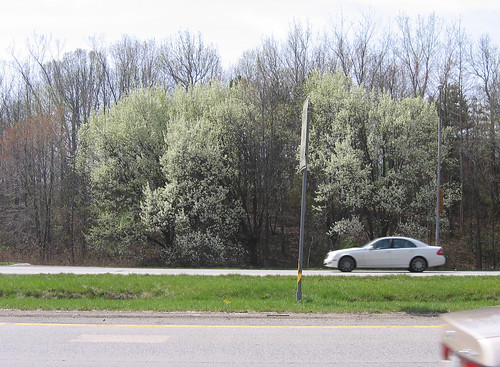 Callery pear (Pyrus calleryana) planted along Rt 440 in Staten Island.
Callery pear (Pyrus calleryana) planted along Rt 440 in Staten Island.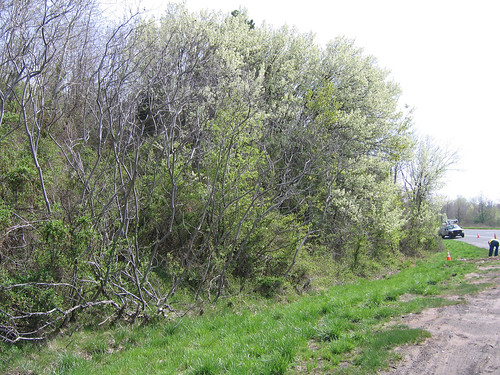 Callery pear (Pyrus calleryana) volunteering along Rt 440 in Staten Island.
Callery pear (Pyrus calleryana) volunteering along Rt 440 in Staten Island.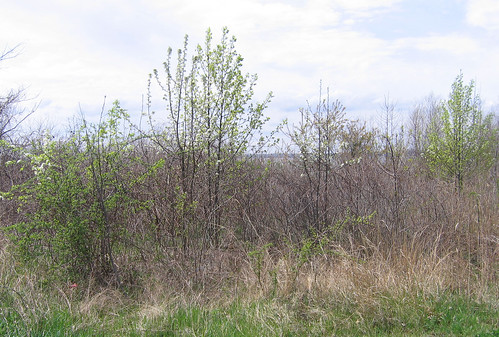 Callery pear (Pyrus calleryana) now found in Conference House Park. That was easy math.
Callery pear (Pyrus calleryana) now found in Conference House Park. That was easy math.
Posted by
drosera
at
10:38 PM
1 comments
![]()
Labels: invasive, NYC Parks, springtime, Staten Island, trees
Last year was my first time at Corson's Brook Woods, and it made a big impression on me - such a mecca of spring wildflowers! So, I visited again this year and it did not disappoint. Blue cohosh (Caulophyllum thalictroides). A striking spring ephemeral, with its unusual flower color and greyish blue glaucous stem. Rare in NYC.
Blue cohosh (Caulophyllum thalictroides). A striking spring ephemeral, with its unusual flower color and greyish blue glaucous stem. Rare in NYC.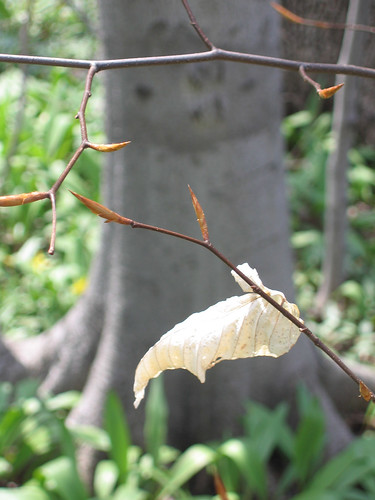 American beech (Fagus grandifolia). I don't know why, but beech trees hold onto their leaves all winter. They are a welcome splash of color in a winter woodland - and even in spring. Rich forest soils.
American beech (Fagus grandifolia). I don't know why, but beech trees hold onto their leaves all winter. They are a welcome splash of color in a winter woodland - and even in spring. Rich forest soils.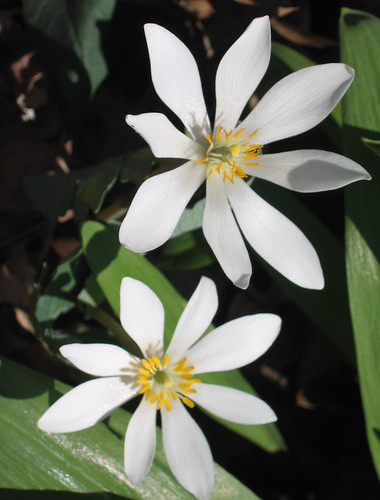
Bloodroot (Sanguinaria canadensis). Pure white. Lovely and fleeting. Rare in NYC. Trout lily (Erythronium americanum). An impressive amount, it just went on and on. These types of shade tolerant species are slow growing, and so such large colonies are very old - the population could've been many decades old.
Trout lily (Erythronium americanum). An impressive amount, it just went on and on. These types of shade tolerant species are slow growing, and so such large colonies are very old - the population could've been many decades old.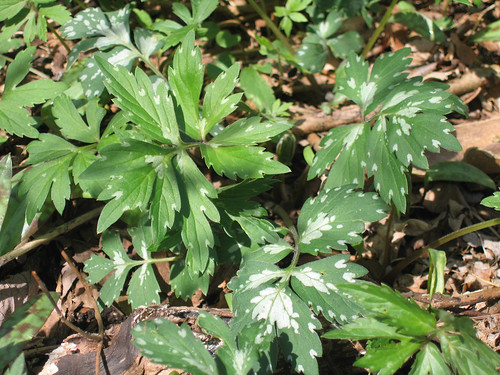
Virginia waterleaf (Hydrophyllum virginianum). Decorative foliage - the silvery spots that look like water stains. I'm surprised this isn't used more in the hort trade. It's a great groundcover. Found in rich forest soils and floodplains. Rare in NYC.
Posted by
drosera
at
10:06 PM
1 comments
![]()
Labels: ferns, forests, spring ephemerals, springtime, Staten Island, wildflowers
An excellent overview of the phenomenon - how people don't see plants - from Tuesday's Science Times.
We barely notice plants, can rarely identify them and find them incomparably inert. “Animals are much more vivid to the average person than plants are,” Dr. Raven said, “and some people aren’t even sure that plants are alive.”
*sigh* sadly, it's true. Although, in my experience, people do notice trees, and care a heck of a lot about garden flora.
Posted by
drosera
at
12:24 PM
2
comments
![]()
Labels: botanical news, native plants, trees
Parks does it again. Now the issue is natural areas within golf courses (that were originally carved out of...natural areas). Split Rock Golf Course in Pelham Bay Park in the Bronx is now under new management. It seems there was nothing in the contract about leaving things as is . These folks want every blessed inch within the fence to be golf turf. Arck! And we had just gotten the other company to stop mowing the rare purple milkweed!

Now you don't! Chipped into a woody pulp. It goes on...I just don't have the stomach for this anymore.
Posted by
drosera
at
10:44 PM
0
comments
![]()
Labels: Bronx, endangered, forests, golf course, NYC Parks, rare, trees
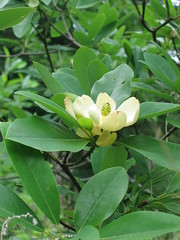
The spectacular bloom of a magnolia may be a very common sight in gardens, but in the wild it is a different story.
A new report has found that over half the world's magnolia species are
facing extinction in their forest habitats. To wit, the sweetbay magnolia pictured here
Posted by
drosera
at
4:26 PM
0
comments
![]()
Labels: botanical news, extinct, forests, magnolia, rare
This is my northfacing windowbox. It contains maidenhair fern, wild columbine, wood poppy, common blue violet, and blue wood sedge (Carex flaccosperma). It's bluish-green leaves overwintered (evergreen), but are tender, so they do get brown.
This plant shouldn't be in flower until the end of April, but I guess no one told it that. You can clearly see the male flowers - the lemon yellow anthers - at the top of the inflorescence. The female flowers - clear stigmas - have yet to emerge below.
Posted by
drosera
at
10:07 PM
0
comments
![]()
Labels: evergreen, gardening, sedge, springtime